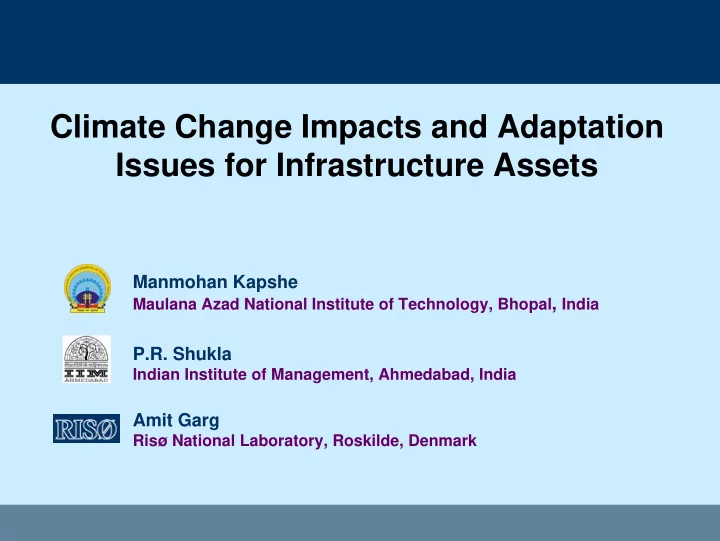

Climate Change Impacts and Adaptation Issues for Infrastructure Assets Manmohan Kapshe Maulana Azad National Institute of Technology, Bhopal , India P.R. Shukla Indian Institute of Management, Ahmedabad, India Amit Garg Risø National Laboratory, Roskilde, Denmark
Issues of Development and Climate • Long-life assets (e.g. infrastructure) are essential for development • Huge investments are being committed in developing countries • Most infrastructure assets are exposed to climate • Development and climate change would impact long-life assets • Infrastructures have low autonomous adaptive capacity • Impact are more directly associated with climatic extremes rather than averages • Infrastructures are not assessed for climate impacts and adaptation • Higher economic damages in developed / industrialized areas but higher human damages in less-developed areas • Infrastructures are also part of adaptation strategies
Categories of Climate Impacts • Environmental quality (e.g., Air pollution, water logging or salinity increase, etc.) • Linkage systems (e.g., threats to water supply or storm effects on power supply, increased competition for critical inputs) • Social infrastructure (e.g., changed energy/water/health requirements, heat island effects, disruptive severe weather events, reductions in resources for other social needs, environmental migration, changes in local ecologies) • Physical infrastructure (e.g., flooding, storm damage, changes in the rate of deterioration of materials, changed requirements for such infrastructures as water supply) • Economic infrastructure and comparative advantages (e.g., costs and risks increase, markets or competitors affected)
Adaptation Strategies • Facilities and linkages against extreme weather-related events • Contingency planning (such as stockpiling) • Changes in financial mechanisms to increase resiliency • Increased efficiencies in thermal conditioning • Relocation and industrial restructuring • Planning for likely increase in demands • Adaptation by industry with adjustments to changes in climatic parameters • Attention to the security of transportation and other linkage infrastructures • Risk financing and risk mitigation
Projected changes in temperature and precipitation on a regional scale for India Projections of seasonal precipitation for the period 2041-60, based on the regional climate model HadRM2 Source: India’s Initial National Communication, 2002
Climate Projections: Summary Maximum temperature: Increase by 2-4 ° C during 2050s in regions above 25 o N. Minimum temperature: Increase up to 4 o C all over the country. May exceed 4 ° C over southern peninsula, northeast India and some parts of Punjab, Haryana and Bihar. Monsoon Rainfall: Marginal changes in monsoon months (JJAS) Large changes during non-monsoon months Number of rainy days: Decrease in the number of rainy days over a major part of the country. More in western and central part (by more than 15 days) while near foothills of Himalayas (Uttaranchal) and in northeast India the number of rainy days may increase by 5-10 days. Extreme Rainfall events : Overall increase in the rainy day intensity by 1-4 mm/day except for small areas in northwest India where the rainfall intensities decrease by 1 mm/day. Cyclonic storms : Increase in frequency and intensity of cyclonic storms is projected
Secondary Climate Changes Increase in Extreme Events Sea Level Rise Precipitation Increase Temperature Rise Humidity Water Availability Sedimentation Flooding /Water Logging Vegetation Mangroves Marine Life Structural Stability Land Slide Land Erosion
Assessment Framework: Incorporating Development and Climate Change paradigm for impact assessment Future impacts on a system = fn. (SDV i , CCV j , SCV k ) where, SDV = Projections for relevant Sustainable Development Variables i = Technology, institutions (e.g. for governance and implementation), economic instruments (e.g. insurance, etc), other policies (e.g. forestation, intensive cropping, etc.) CCV = Projections for relevant Climate Change Variables j = Temperature, rainfall, sea level rise, extreme events, secondary variables (e.g. vegetation, land slides, water logging, etc.) SCV = Projections for relevant System Condition Variables k = Life, maintenance levels, usage patterns, soil type, etc.
Reverse Impact Matrix Dependent Variables Environmental Project Components Variables Environmental Variables Conventional Project Components Environmental Impact Matrix Forcing Variables
Case Study: Konkan Railway � 760 Kms along Western coastal ghats � $745 million project � Considered and engineering marvel with: � 179 main bridges � 1819 minor bridges, � 92 tunnels (covering 12% of total route) � >1000 cuttings (224 deeper than 12 meters) � Longest tunnel is 6.5 Km long � Longest bridge is over 2 Km. � The pillars of the tallest viaduct bridge are more than 64 meters high.
Konkan Railway: Revenues and Expenses Revenue Generation by Konkan Railway 2000 1500 Million Rs. 1000 Traffic Revenue 500 0 1994 1995 1996 1997 1998 1999 2000 2001 Expenses of Konkan Railway 500 400 Million Rs. 300 200 100 0 1994 1995 1996 1997 1998 1999 2000 2001 Fuel Staff Repair & Maintenance
Climate Change: A case of Konkan Railway Climatic Parameter Impact Parameter Intervening Parameter Impact on KRC High evaporation rate Stability and Strength of the Buildings gets weakened More and building materials frequent repair and maintenance Surface and ground water loss Crop productivity in the region may Agricultural fright traffic Temperature Increase be affected Need for Air-conditioning Passenger traffic may shift to Air Affects efficiency, carrying capacity conditioned class and composition. Buildings affected, structural damages Ground and surface water level Flooding and water logging, Erosion may take place. Increased maintenance change reduces quality of land cover and other related costs Improved water availability in the Agricultural production Changes in agricultural freight traffic Rainfall Increase region Humidity increase Uncomfortable climatic conditions, Passenger traffic, affected, increased Vegetation growth along the track maintenance cost Tracks tunnels and bridges may be Land erosion Increased maintenance, affected Flooding Land stability, and land slides Damage to infrastructure, Sea Level Change Reconstruction and relocation Water logging Delays, risk increase Cyclone and high velocity winds Damage to buildings, Disruption of services, repair and and storms communication lines etc reconstruction costs Extreme Events Cloud bursts Land erosion, floods, and land Extensive damage to infrastructure, slides High cost of repair and reconstruction
Recommend
More recommend